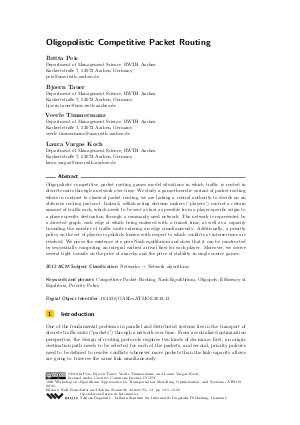Oligopolistic Competitive Packet Routing
Authors Britta Peis, Bjoern Tauer, Veerle Timmermans, Laura Vargas Koch
-
Part of:
Volume:
18th Workshop on Algorithmic Approaches for Transportation Modelling, Optimization, and Systems (ATMOS 2018)
Part of: Series: Open Access Series in Informatics (OASIcs)
Part of: Conference: Symposium on Algorithmic Approaches for Transportation Modelling, Optimization, and Systems (ATMOS) - License:
 Creative Commons Attribution 3.0 Unported license
Creative Commons Attribution 3.0 Unported license
- Publication Date: 2018-08-28
File

PDF
OASIcs.ATMOS.2018.13.pdf
- Filesize: 0.5 MB
- 22 pages
Document Identifiers
Subject Classification
ACM Subject Classification
- Networks → Network algorithms
Keywords
- Competitive Packet Routing
- Nash Equilibrium
- Oligopoly
- Efficiency of Equilibria
- Priority Policy
Metrics
- Access Statistics
-
Total Accesses (updated on a weekly basis)
0PDF Downloads0Metadata Views
Abstract
Oligopolistic competitive packet routing games model situations in which traffic is routed in discrete units through a network over time. We study a game-theoretic variant of packet routing, where in contrast to classical packet routing, we are lacking a central authority to decide on an oblivious routing protocol. Instead, selfish acting decision makers ("players") control a certain amount of traffic each, which needs to be sent as fast as possible from a player-specific origin to a player-specific destination through a commonly used network. The network is represented by a directed graph, each edge of which being endowed with a transit time, as well as a capacity bounding the number of traffic units entering an edge simultaneously. Additionally, a priority policy on the set of players is publicly known with respect to which conflicts at intersections are resolved. We prove the existence of a pure Nash equilibrium and show that it can be constructed by sequentially computing an integral earliest arrival flow for each player. Moreover, we derive several tight bounds on the price of anarchy and the price of stability in single source games.
Cite As Get BibTex
Britta Peis, Bjoern Tauer, Veerle Timmermans, and Laura Vargas Koch. Oligopolistic Competitive Packet Routing. In 18th Workshop on Algorithmic Approaches for Transportation Modelling, Optimization, and Systems (ATMOS 2018). Open Access Series in Informatics (OASIcs), Volume 65, pp. 13:1-13:22, Schloss Dagstuhl – Leibniz-Zentrum für Informatik (2018)
https://doi.org/10.4230/OASIcs.ATMOS.2018.13
BibTex
@InProceedings{peis_et_al:OASIcs.ATMOS.2018.13,
author = {Peis, Britta and Tauer, Bjoern and Timmermans, Veerle and Vargas Koch, Laura},
title = {{Oligopolistic Competitive Packet Routing}},
booktitle = {18th Workshop on Algorithmic Approaches for Transportation Modelling, Optimization, and Systems (ATMOS 2018)},
pages = {13:1--13:22},
series = {Open Access Series in Informatics (OASIcs)},
ISBN = {978-3-95977-096-5},
ISSN = {2190-6807},
year = {2018},
volume = {65},
editor = {Bornd\"{o}rfer, Ralf and Storandt, Sabine},
publisher = {Schloss Dagstuhl -- Leibniz-Zentrum f{\"u}r Informatik},
address = {Dagstuhl, Germany},
URL = {https://drops.dagstuhl.de/entities/document/10.4230/OASIcs.ATMOS.2018.13},
URN = {urn:nbn:de:0030-drops-97186},
doi = {10.4230/OASIcs.ATMOS.2018.13},
annote = {Keywords: Competitive Packet Routing, Nash Equilibrium, Oligopoly, Efficiency of Equilibria, Priority Policy}
}
Author Details
- Department of Management Science, RWTH Aachen, Kackertstraße 7, 52072 Aachen, Germany
References
-
Elliot Anshelevich, Anirban Dasgupta, Jon Kleinberg, Eva Tardos, Tom Wexler, and Tim Roughgarden. The price of stability for network design with fair cost allocation. SIAM Journal on Computing, 38(4):1602-1623, 2008.

-
Nadine Baumann and Martin Skutella. Earliest arrival flows with multiple sources. Mathematics of Operations Research, 34(2):499-512, 2009.

-
Lisa K Fleischer. Faster algorithms for the quickest transshipment problem. SIAM journal on Optimization, 12(1):18-35, 2001.

-
Lisa K Fleischer and Martin Skutella. Quickest flows over time. SIAM Journal on Computing, 36(6):1600-1630, 2007.

-
David Gale. Transient flows in networks. Michigan Math. J., 6(1):59-63, 1959.

-
Tobias Harks, Britta Peis, Daniel Schmand, Bjoern Tauer, and Laura Vargas Koch. Competitive packet routing with priority lists. ACM Trans. Econ. Comput., 6(1):4:1-4:26, March 2018.

-
David G. Harris and Aravind Srinivasan. Constraint satisfaction, packet routing, and the lovasz local lemma. In Proceedings of the Forty-fifth Annual ACM Symposium on Theory of Computing, STOC '13, pages 685-694, New York, NY, USA, 2013. ACM.

-
Martin Hoefer, Vahab S Mirrokni, Heiko Röglin, and Shang-Hua Teng. Competitive routing over time. Theoretical Computer Science, 412(39):5420-5432, 2011.

-
John J Jarvis and H Donald Ratliff. Note - some equivalent objectives for dynamic network flow problems. Management Science, 28(1):106-109, 1982.

-
Ronald Koch, Britta Peis, Martin Skutella, and Andreas Wiese. Real-time message routing and scheduling. In Approx., Rand., and Comb. Opt. Algorithms and Techniques, pages 217-230. Springer Berlin Heidelberg, 2009.

-
Elias Koutsoupias and Christos Papadimitriou. Worst-case equilibria. In Stacs, volume 99, pages 404-413. Springer, 1999.

-
Janardhan Kulkarni and Vahab Mirrokni. Robust price of anarchy bounds via lp and fenchel duality. In Proceedings of the Twenty-Sixth Annual ACM-SIAM Symposium on Discrete Algorithms, pages 1030-1049. SIAM, 2014.

-
Frank Thomson Leighton, Bruce M Maggs, and Satish B Rao. Packet routing and job-shop scheduling in 𝒪(congestion + dilation) steps. Combinatorica, 14(2):167-186, 1994.

-
Nimrod Megiddo. Optimal flows in networks with multiple sources and sinks. Mathematical Programming, 7(1):97-107, 1974.

-
Edward Minieka. Maximal, lexicographic, and dynamic network flows. Operations Research, 21(2):517-527, 1973.

-
Britta Peis and Andreas Wiese. Universal packet routing with arbitrary bandwidths and transit times. In Proceedings of the 15th International Conference on Integer Programming and Combinatoral Optimization, IPCO'11, pages 362-375, Berlin, Heidelberg, 2011. Springer-Verlag.

-
Thomas Rothvoß. A simpler proof for o(congestion + dilation) packet routing. CoRR, abs/1206.3718, 2012.

-
Tim Roughgarden. Routing games. In Algorithmic Game Theory, pages 461-486. Cambridge Univ. Press, 2007.

-
Christian Scheideler and Berthold Vöcking. From static to dynamic routing: Efficient transformations of store-and-forward protocols. SIAM Journal on Computing, 30(4):1126-1155, 2000.

-
Martin Skutella. An introduction to network flows over time. In Research trends in combinatorial optimization, pages 451-482. Springer, 2009.

-
Aravind Srinivasan and Chung-Piaw Teo. A constant-factor approximation algorithm for packet routing and balancing local vs. global criteria. SIAM Journal on Computing, 30(6):2051-2068, 2001.

-
Stevanus Adrianto Tjandra. Dynamic network optimization with application to the evacuation problem. Shaker, 2003.

-
William L Wilkinson. An algorithm for universal maximal dynamic flows in a network. Operations Research, 19(7):1602-1612, 1971.

